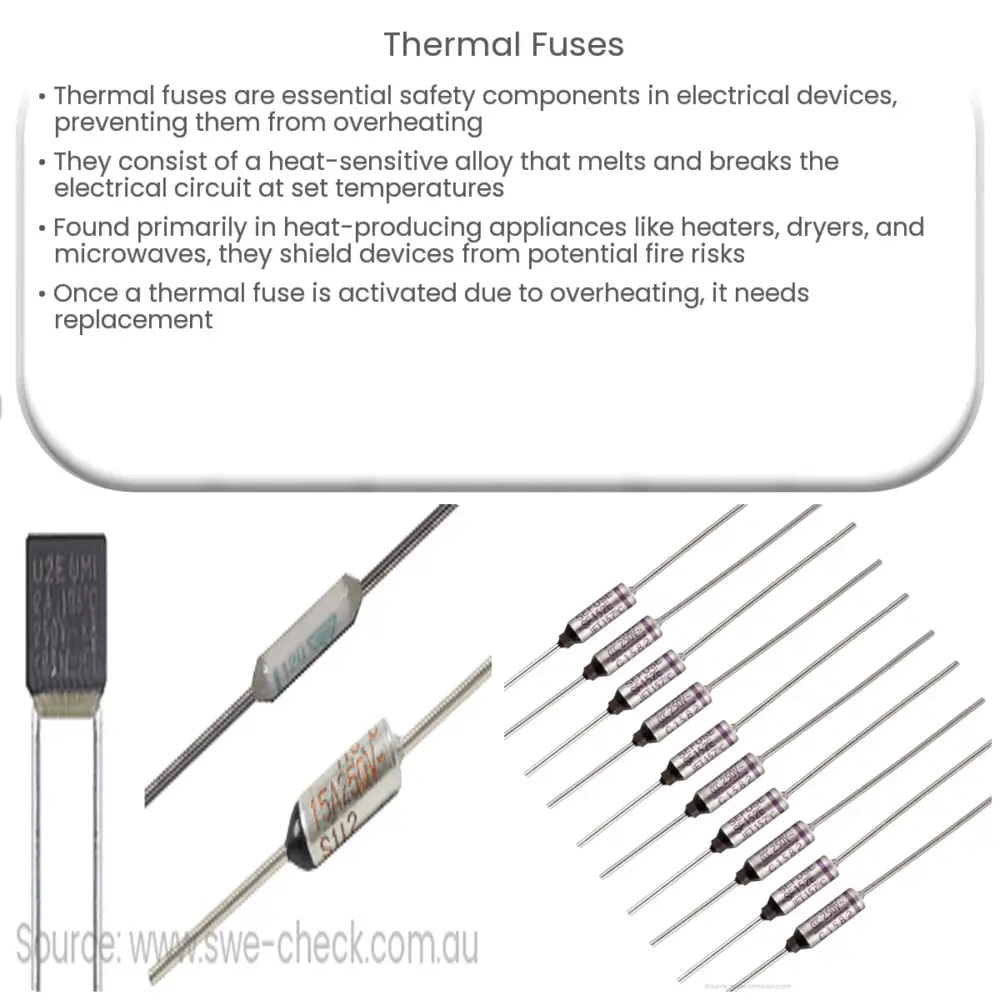Explore the role of thermal fuses in electrical safety, their operation, types, advantages, and how to replace them.

Introduction to Thermal Fuses
A thermal fuse is a critical safety component used in electrical devices to prevent them from overheating. This piece of equipment operates as a heat sensor, designed to break an electrical circuit when heated to a specific temperature, thereby stopping the flow of electricity.
Operation Principle of Thermal Fuses
Thermal fuses are made of a heat-sensitive alloy that is constructed to melt and interrupt the circuit at specific temperatures. When the surrounding temperature of the device reaches the designated limit, the fuse’s alloy melts, resulting in the interruption of the electrical circuit. This immediate interruption of electricity can prevent potential fires or other hazards associated with overheating.
Types of Thermal Fuses
- Radial Thermal Fuse: These types of fuses are commonly found in home appliances. They contain a pellet that melts at a specific temperature and causes the device to stop operating.
- Axial Thermal Fuse: This variant has leads at both ends and is widely used due to its compact design. It’s primarily found in compact and portable electrical devices.
Where are Thermal Fuses used?
Thermal fuses are primarily utilized in heat-producing electrical appliances. These can be found in a wide range of household and industrial appliances such as:
- Electric heaters
- Hair and clothing dryers
- Coffee makers
- Microwaves
- Refrigerators and freezers
They serve to protect these devices from potential fire hazards by cutting off the electrical supply when the device exceeds a certain temperature limit.
Importance of Thermal Fuses
Thermal fuses act as the last line of defense in many electrical appliances. They’re designed to protect not only the device they are installed in but also the surrounding environment and the users. These fuses are a crucial part of electrical safety measures in both domestic and industrial settings.
Advantages of Thermal Fuses
Thermal fuses have several advantages which have made them an industry standard for electrical safety:
- They’re simple in design and therefore relatively inexpensive to manufacture.
- They provide reliable operation, typically failing in a safe manner when they do fail.
- Their small size allows them to be incorporated into a wide range of appliances.
Despite their simplicity, thermal fuses are a vital safety feature in countless devices that we rely on every day.
Limitations of Thermal Fuses
While thermal fuses provide a high level of safety, they are not without their limitations. A major drawback of thermal fuses is their one-time use. Once a thermal fuse has been triggered due to overheating, it cannot be reset and must be replaced. This necessitates the disassembly of the device, the replacement of the fuse, and then the reassembly of the device. Furthermore, thermal fuses might not react quickly enough in some circumstances, as they only respond to high temperatures and not overcurrent conditions.
How to Replace a Thermal Fuse
- Firstly, you must disconnect the appliance from the power source.
- Then, locate the thermal fuse within the appliance. The location of the thermal fuse varies depending on the appliance type and model.
- Using an appropriate tool, such as a multimeter, check the continuity of the fuse. If there is no continuity, the fuse is blown and needs replacement.
- Replace the blown fuse with a new one of the exact same specifications.
- Reassemble the appliance and reconnect it to the power source.
Note: Always seek the help of a professional if you’re unsure of this process. It involves working with electrical components and should be carried out with utmost care.
Conclusion
In conclusion, thermal fuses play a pivotal role in electrical safety. Despite their simplicity and small size, their function is paramount in preventing potential fires and other hazards associated with overheating of electrical appliances. While they have their limitations, such as their one-time use and inability to react to overcurrent situations, the importance of thermal fuses in everyday devices cannot be understated. Regular checks and timely replacements of these components can ensure the longevity of appliances and more importantly, the safety of users.

